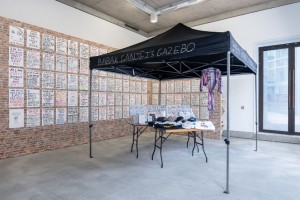Radical Conservatism — Reviewed

Lauren Velvick questions her own beliefs, history and identity during a visit to Castlefield Gallery’s latest exhibition…
Can conservatism ever be a radical stance? Pil & Galia Kollectiv return to Castlefield this winter with their curated exhibition, Radical Conservatism; a show that, as part of the gallery’s art and society strand, seeks to question and redefine our ideas of radicalism and conservatism.
This exhibition is part of a wider research project, developed out of a fellowship programme at The Henry Moore Institute, Leeds, where the curators came across Oscar Nemon’s abundant plans for a Temple of Universal Ethics, “randomly in the HMI catalogue.”
Nemon (1906-1985) had also sculpted busts of various politicians, and it is three white plaster and porcelain studies of Thatcher — along with a similarly white model of Nemon’s Temple — that form an initial axis, by which we can place and consider the other works in the show. The eerie arrangement of Nemon’s three studies bring to mind the proposed Margaret Thatcher Library and Museum, raising pertinent questions around power and memorial.
Within earshot of this cluster of heads plays Chris Evans’ film Company (2009), framing extreme regeneration and the creation of secluded gated communities as a creative pursuit. Evans’ protagonist, Walid El Kafrawy, is the chief executive of an Egyptian construction company, and in the film refers repeatedly to forces that work through people to shape cities and communities. The viewer is implored to consider how cities have found their form, and by what forces; highlighting how narratives can be suppressed as others are sanctioned.
On the lower floor, Nemon’s Temple of Universal Ethics is a beautiful and impossible plan. The melancholy of a monument never completed is amplified here with the Temple’s resemblance (in shape at least) to Manchester’s own uncertain monument to culture and the city, Urbis, now the National Football Museum.
Looking down upon Nemon’s Temple are Pil & Galia’s Proposals For a Future Monument For the Dialectic Negation of a Post-Catastrophic Society (pictured); plans that brazenly represent current pre-eminent forces. These proposals are formed from images of yachts, a clear and recognisable symbol of the super-rich, layered and pieced together to create futuristic structures that could almost be real designs, to be made in glass and steel.

The works in this exhibition contain subtle references to everyday life and common knowledge, whilst also appearing as mysterious artefacts from an alternate reality. Joseph Lewis’s Positiv Churches (2013) exemplify this; referring explicitly to pagan traditions that have informed British Christian folklore, with the green man appearing alongside ecclesiastical motifs. These alternative reliquaries are formed with time-honoured materials and methods that connote, if not sacredness, at least superstition and symbolic embellishment, such as carved timber, coloured threads, bone and gold.
In all their apparent sincerity, Lewis’s Positiv Churches, along with various other works on this lower floor, are redolent of inauthentic or faked historical antiquities, raising questions around what we believe about our own histories and identities.
Similarly, The IRWIN Group present a triptych including painted icons of indeterminate age, framed according to a Dada aesthetic, and originating from a project in 2012. The group sought to advocate a little known Dada origin story, claiming it as a source for the movement in orthodox mysticism.
Alongside the work of IRWIN and Lewis, Patrick Moran’s Buried, a brutal death-metal zine, at first appears to be another artefact of dubious origin. However, Buried is a current publication, and here it presents a re-making of folklore, disregarding questions of historical accuracy or authenticity, highlighting our struggle for verification amongst a surfeit of information.
Whist Lewis, Irwin and Moran’s works reinforce each other atmospherically, two short films by Public Movement play in the background, examining and enacting performances of power. University Exercise (2010) depicts a “public behaviour drill”, organised by the group at The University of Heidelberg, which seems like a sort of resistance practice, giving the participants an opportunity to observe their own limits.
As a collection, the works on show lurch back and forth, sidelining historicity, and creating a sense of mystery and vertigo that could be confusing, especially if you’re expecting answers to the questions posed in the press release.
However, for Pil and Galia an exhibition is just one platform within a wider active research project. They declare: “the thematic group exhibition is, for us, a means of juxtaposing disparate practices that we think can be brought together to shed a new light on the terms in question.”
Overlapping but distinct ideas, rich in cultural connotations and everyday applications, are exhibited here, in an enquiry that will continue in the new year with a symposium on 1 February 2014.
Lauren Velvick
Radical Conservatism. Curated by Pil and Galia Kollectiv continues until 2 February 2014. A special symposium takes place 1 February 2014, see here for details
Gallery open Wed-Sun, 1-6pm. Christmas Closing: Mon 21 Dec 2013 to Tues 7 Jan 2014, reopening Weds 8 Jan 2014





